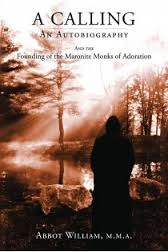This is the second part of my article on “The Maronite Monks of Adoration”. It is dedicated to the first part of a review of Abbot William’s valuable spiritual testimony: A Calling: An Autobiography a Founding of the Maronite Monks of Adoration (Leonine Publishers, Phoenix, 2012, 271pp.). I shall not attempt to describe my meeting with the Abbot and his monks. One of the features of the book, however, is the full colour photography depicting the monastery and its monks, including the Abbot.
As the title suggests, the book simply tells the story of Abbot William and how he came to found the Maronite Monks of Adoration. The biographical narrative commences in chapter 2, which is devoted to his growing up in the years 1932 to 1945. As he states: “In the 1940s, religion was a vibrant, meaningful aspect of daily life” (p.10). The good Abbot draws several lessons from his childhood, but one with which I heartily agree, is this: “Especially contrived religious services for children may not in fact satisfy the child’s inner needs and can, unintentionally hurt their innate sense of religion, their faith, and their inner psychological response to religion and faith. I believe the child is capable of genuinely deep acts of faith” (p.15). As a teenager, I was driven from the church by Masses specially designed for us in which we were all supposed to play a role. And to the best of my knowledge, I am now practically the only one of 100 school-fellows who regularly attends Mass and takes his faith seriously. Our generation was massacred for the faith by “relevant” not catechetical teaching, and the smug self-satisfied dismissal of the religion of our parents.
With the same wisdom, our guide writes: “The premium we place on youth today, to the extent that adults dress and act like youth under the impression that they will win the youth over, is a great psychological miscalculation. It is one thing indeed to let the young be young and quite another for adults to pretend they are young while holding the young down” (p.55).
But I wander: for me, perhaps the most powerful line in chapter 2 is this one: “We can say that as the family goes, so go our loves and our hates” (p.13). So much comes into my mind and heart as I ponder this that I know I must leave it for another blog.
Then, in chapter 3, the Abbott deals with his teenage years, and makes the sad but uncompromising observation, true also for my youth: “If I were to critique my Catholic education, I would say that an ideal of life was not held up, or certainly not sufficiently held up, to the young as an actual possibility” (p.25). I would only add that the very adulation of the young leads to dismissing any ideal as unrealistic. The lack of an ideal held up as a serious aim is the final result of the taking the faith for granted, and failing to teach it, as the author had remarked at p.23.
By chapter 4, our subject has graduated, and is searching for a religious community to join. One interesting claim, which I feel is at least 85% correct, is that behind the sexual issues which are plaguing the Church, stands the deeper issue of orthodoxy (p.31).
In this chapter we find the first of many profound comments about discerning a vocation. The first sign of a vocation from God is, Abbot William states, a persevering attraction to the religious life (p.33). If a man has that, then there is a serious possibility of a true vocation. This is the final chapter of Pt I.
Pt II deals with the years 1951 to 1963 when the author was living the religious life. I commend the photograph of him reading the Lectio Divina at the present monastery in Petersham (p.37). In this chapter, the fifth, and one of the most significant, he states that one thing he learned from community life was that: “Monastic life and any genuine spiritual Christian life heightens and perfects one’s individual temperaments and gifts …” (p.41).
Abbot William is not afraid to broach a rather abstruse and rarely explored question: what sort of practical efficiency should a monk have? He is decidedly against the “can-do” American approach with its brusque businesslike self-importance. The average candidate for monastic life, at least in the USA, has been raised in that mentality: you punch the clock, work efficiently, punch off, and you’re done for the day. The true monastic attitude, he avers, is informed by that of the older agrarian society: “In agrarian society … the work on the farm is never done. One did not punch the clock on the farm. The chores were always there … The farmer handled his task and survived by his ability to work his farm at a “farmer’s pace”. The farm candidate brought that particular culture and manner of living to the monastery” (p.45, but see also pp.44-48).
Together with this comes a prolonged meditation on the nature of change, and how to discriminate when to change and when not to. The Abbot quotes someone on the confusion of “activity” with “activism”, and goes on to say that too much change in any order can destroy its roots: those roots are its “charism”. If the nature of that charism is mistaken, the result is disaster (pp.48-50).
Here, too, our guide introduces the phrase “the deep things of the interior life”, and how the abbot bears the responsibility for bringing them forward” (p.49). He notes, too, that there was a “deluge of vocations” to the monasteries in the 1950s: he attributes this to the optimism, confidence and faith which came from two sources – the victory in WWII and the unchanging eminence and sturdiness of the faith (p.50).
To be continued
